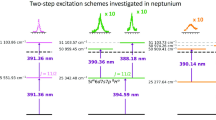Summary
The absorption coefficient, corresponding to optical transitions starting from the ground state of theF center in alkali halides, is modulated if the population of such a state is periodically varied by means of a chopped beam of excitingF light. With the above method it is shown that theL bands in KCl correspond to transitions to higher excited states of theF center situated at energies within the conduction band. The analysis of the results shows that a fraction of the excitedF* centers decays through the process:F*+F →F′+vacancy; followed byF′+vacancy → 2F. Such processes occur by means of tunneling of the excited electron to a neighbouringF center, followed by field ionization of the createdF′ center caused by the vacancy left behind. The characteristic times of the two processes are measured and are: τ1=3·10−5 s, τ2=4·10−3s for a crystal of KCl containing 1.2·1017 F centers/cm3. It is suggested that the quenching of theF luminescence observed at high concentrations of centers is caused by the occurrence of the process of tunneling. A distance of interaction amongF centers is estimated under the above hypothesis (35 Å).
Riassunto
Il coefficiente di assorbimento ottico corrispondente alle transizioni che partono dal livello fondamentale del centroF negli alogenuri alcalini risulta modulato se la poplazione di tale stato vien fatta variare per mezzo di un fascio di luce eccitatrice di intensità variabile periodicamente. Col metodo descritto viene mostrato che le bandeL nel KCl sono dovute a transizioni dallo stato fondamentale a stati di alta eccitazione del centroF aventi energie nella banda di conduzione. L’analisi dei risultati mostra che una frazione di centriF eccitati decade per mezzo del processo:F*+F → F′+posto vacante, seguito daF′+posto vacante→2F. Tali processi corrispondono al «tunneling» dell’elettrone eccitato a un vicino centroF seguito dalla ionizzazione del centroF′ così formato causato dal campo elettrico del posto vacante residuo. I tempi caratteristici dei due processi vengono determinati e risultanoτ 1=3·10−5,τ 2=4·10−3 s per un cristallo di KCl contenente 1.2·1017 centriF/cm3. Viene suggerito che il «quenching» della luminescenzaF, che si osserva ad alte concentrazioni di centri, è causato dal processo di «tunneling» sopra descritto. Viene stimata, sulla base di tale ipotesi, una distanza di interazione tra centriF di circa 35 Å.
Реэюме
Определяется козффициент поглошения, соответствуюший оптическим переходам иэ основного состоянияF′ центра в шелочных галоидах, если эаселенность такого состояния периодически меняется посредством пучка света, воэбуждаюшего Ж центр, причем, интенсивность света меняется периодически. С помошью выще отмеченного метода покаэывается, что L полосы в КСI соот-ветствуют переходам в высщие воэбужденные состояния Ж центра, знергии которых расположены внутри полосы проводимости. Аналиэ реэультатов покаэывает, что часть воэбужденныхF* центров распадается череэ процесс:F*+F→F′+дырка; и эатемF′+дырка→2F. Эти процессы соответствуют туннельному зффекту воэбужденного злектрона к соседнему Ж центру, эатем иониэации обраэованного Ж′ центра, которая выэвана злектрическим полем оставщейся дыркн. Иэмерены характерные времена двух процессов, которые равны τ1=3·10−5 сек и τ2=4·10−3 сек дня кристалла КС1, содержашего 1.2·1017 F центров в сcm3. Предполагается, что подавление люминесценции, наблюдаемое при высоких концентрациях центров, обусловлено наличием туннельного процесса. Проведена оценка радиуса вэаимодействия междуF центрами, согласно выще укаэанной гипотеэы (35 Å).
Similar content being viewed by others
References
F. Lüty:Zeits. Phys.,160, 1 (1960).
A fourth band which behaves like theL bands (theL 4) has been discovered in the tail of the fundamental absorption of KCl byM. Hirai andM. Ueta:Journ. Phys. Soc. Japan,17, 566 (1962).
R. Wild andF. C. Brown:Phys. Rev.,121, 1296 (1961).
Similar results have been obtained in KBr byR. S. Crandall andM. Mikkor:Phys. Rev.,138, A 1247 (1965);
and in RbCl byG. Spinolo andD. Y. Smith:Phys. Rev.,140, A 2117 (1965).
E. Mollwo:Nachr. Ges. Wissen. Göttingen (1931), p. 77;
H. Ivey:Phys. Rev. 72, 341 (1947).
See for ex.:H. Pick:Suppl. Nuovo Cimento,7, 498 (1958).
R. B. Wood andH. W. Joy:Phys. Rev.,136, A 451 (1964).
R. F. Wood:Phys. Rev. Lett.,11, 202 (1963).
F. Bassani:International Symposium on Color Centers (Urbana, 1965), p. 14.
T. Kojima:International Symposium on Color Centers (Urbana, 1965), p. 87.
C. C. Klick andM. N. Kabler:Phys. Rev.,131, 1075 (1963).
C. C. Klick:Phys. Rev.,137, A 1814 (1965).
H. W. Etzel andF. E. Geiger:Phys. Rev.,96, 225 (1954).
A. Gold:Phys. Rev.,123, 1965 (1961).
F. Nakazawa andH. Kanzaki:Journ. Phys. Soc. Japan,20, 468 (1965).
R. S. Crandall andM. Mikkor:Phys. Rev.,138, A 1247 (1965).
G. Chiarotti andU. M. Grassano:Phys. Rev. Lett.,16, 124 (1966).
D. Frölich andH. Mahr:Phys. Rev.,141, 692 (1966); andPhys. Rev. Lett.,14, 494 (1965).
K. Park:Phys. Rev.,140, A 1735 (1965).
A. A. Meier:Pribory i Tekhnika Eksperimenta,2, 182 (1961).
See Appendix for the condition under which (1) is valid.
We are grateful to Dr.F. Lüty who called our attention to this fact. For the experimental curves see Fig. 7 of ref. (1).
The variations of temperature were obtained by pumping over liquid air.
TheL bands behave like theK hand.
The value ofτ Fv =5.7·10−7s has been measured byR. K. Swank andF. C. Brown:Phys. Rev.,130, 34 (1963).
For the concentration quenching of theF center luminescence see for ex.A. Mielich:Zeits. Phys.,176, 168 (1963).
W. D. Compton andM. N. Kabler:International Symposium on Color Centers (Urbana, 1965), p. 31.
F. Bassani andS. Giuliano:International Symposium on Color Centers (Urbana, 1965), p. 14.
J. H. Simpson:International Symposium on Color Centers (Urbana, 1965), p. 135.
F. Bassani andB. Preziosi: to be published.
Author information
Authors and Affiliations
Rights and permissions
About this article
Cite this article
Chiarotti, G., Grassano, U.M. The excited states of theF center investigated by means of modulated optical absorption. Nuovo Cimento B (1965-1970) 46, 78–92 (1966). https://doi.org/10.1007/BF02710638
Received:
Published:
Issue Date:
DOI: https://doi.org/10.1007/BF02710638




